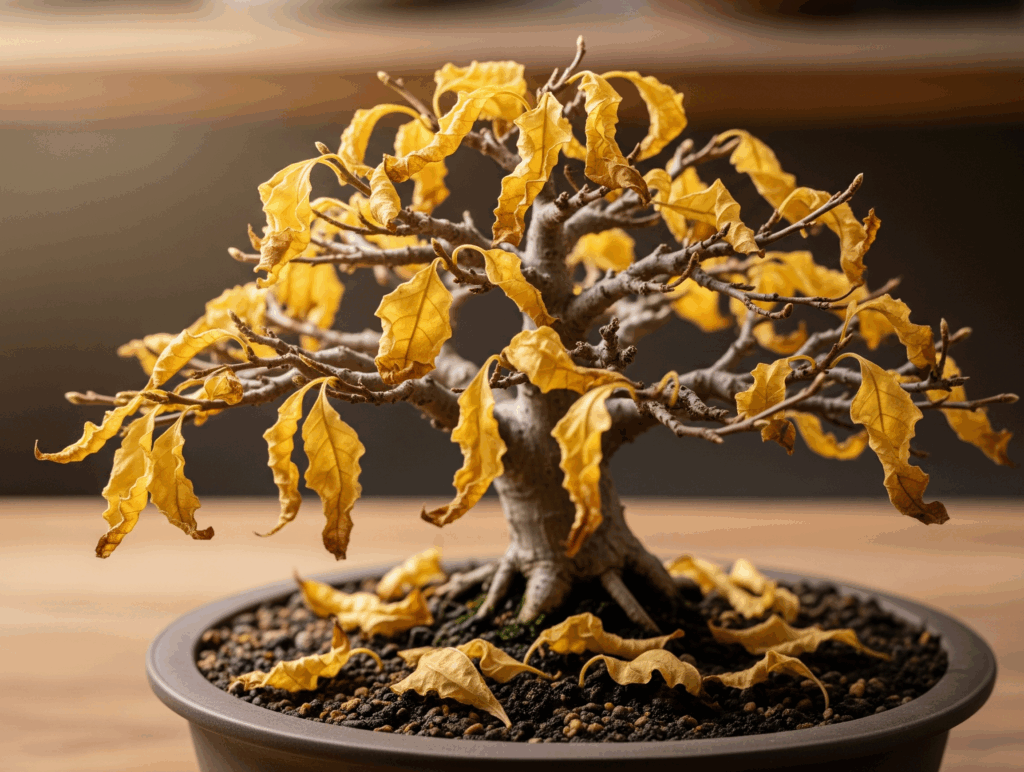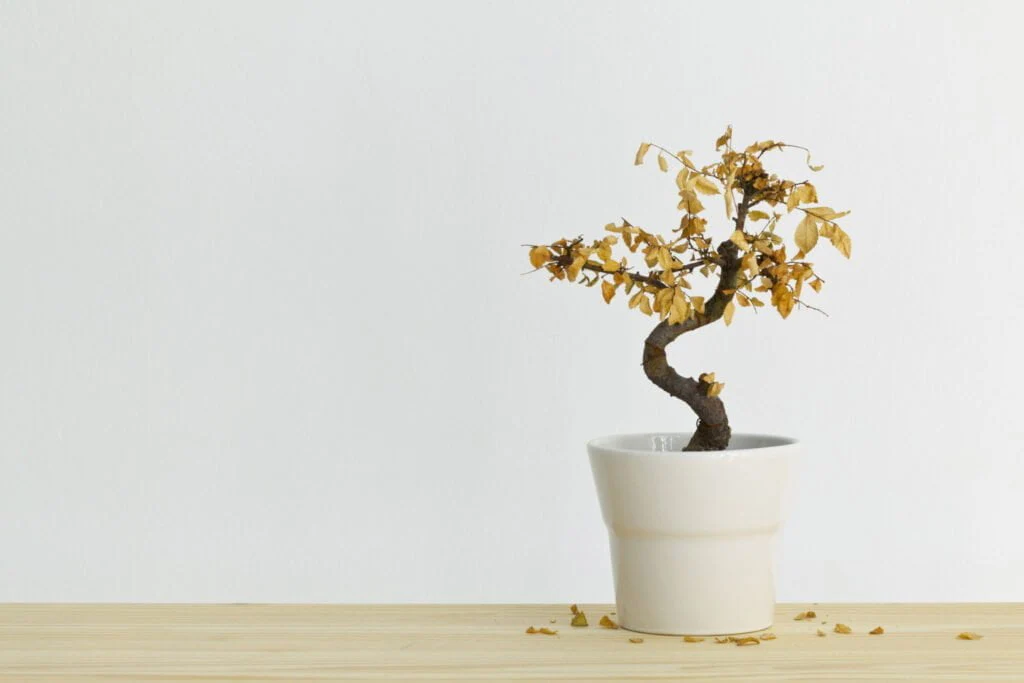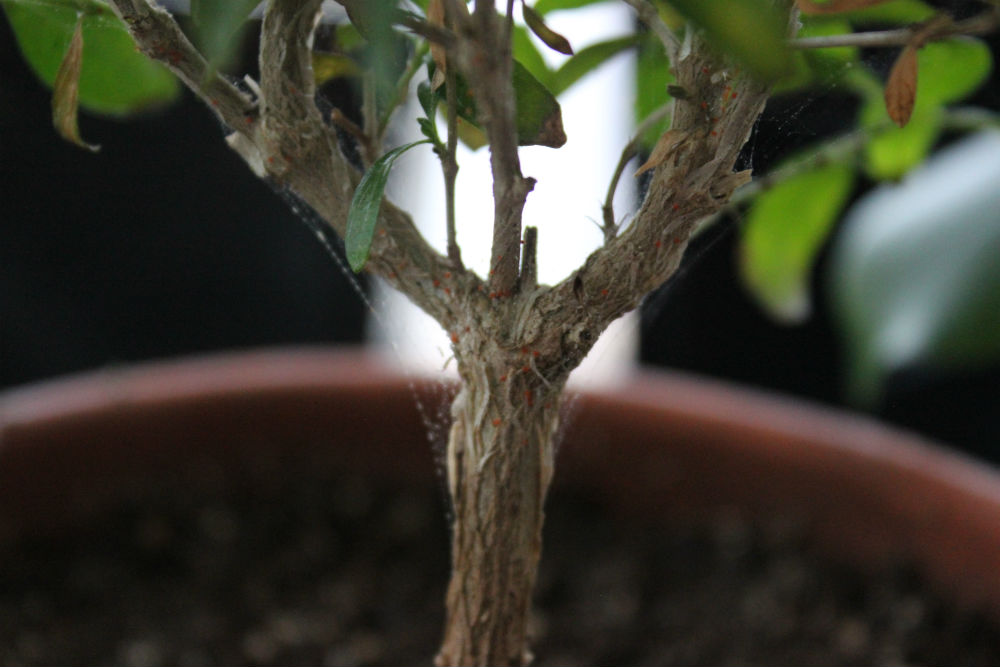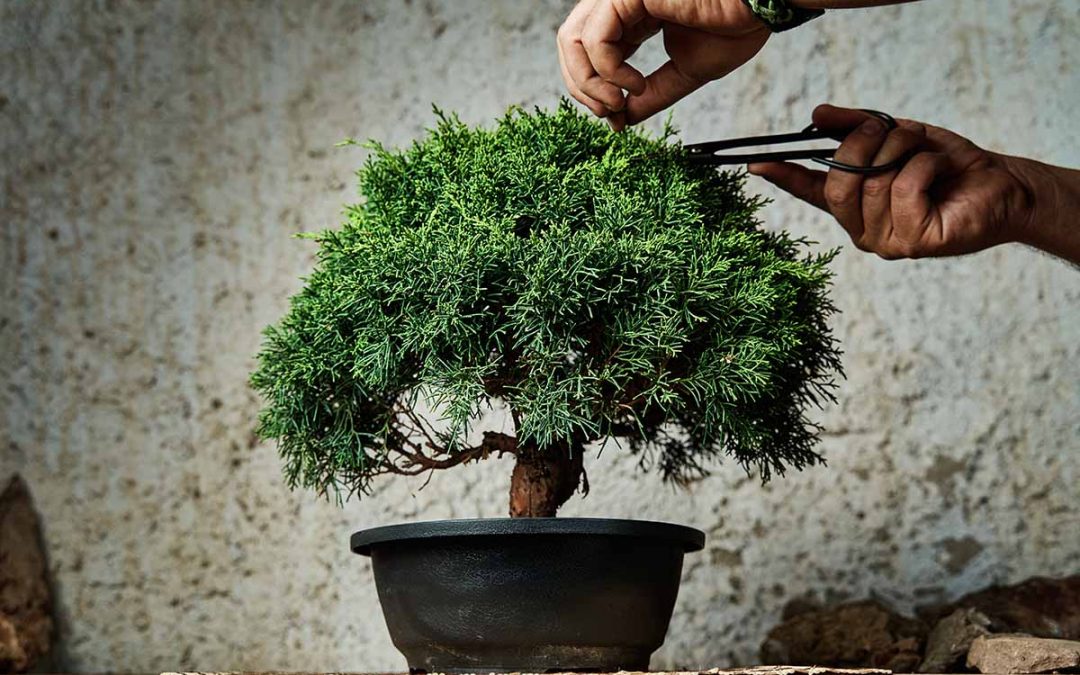Contents
- 1 Common Bonsai Leaf Problems (And How to Fix Them Fast)
- 1.1 1. Yellow Leaves on Bonsai Trees
- 1.2 2. Bonsai Leaves Curling or Crispy
- 1.3 3. Leaf Drop (Sudden or Seasonal)
- 1.4 4. Brown or Black Leaf Tips
- 1.5 5. Pale or Faded Leaves
- 1.6 6. White or Powdery Coating on Leaves
- 1.7 7. Pests on Bonsai Leaves
- 1.8 Preventing Future Leaf Problems
- 1.9 Helpful Tools for Bonsai Leaf Care
- 1.10 Related Articles
- 1.11 Final Thoughts on Bonsai Leaf Problems
- 2 KEEP YOUR BONSAI LEAVES HEALTHY
Common Bonsai Leaf Problems (And How to Fix Them Fast)
Bonsai leaves can tell you everything about your tree’s health — if you know what to look for. Yellowing, curling, or dropping leaves don’t happen by chance. These are early warning signs that your bonsai is stressed and needs attention.
In this guide, you’ll learn how to identify the most common bonsai leaf problems, what causes them, and how to fix each one quickly to restore your tree’s balance and beauty.
1. Yellow Leaves on Bonsai Trees
One of the most common bonsai leaf issues is yellowing foliage. It can be triggered by:
Overwatering – soggy soil suffocates roots and reduces oxygen flow.
Underwatering – soil that dries too often stresses roots and limits nutrient uptake.
Lack of nutrients – old potting mix eventually runs out of minerals.
Low light levels – insufficient sunlight weakens chlorophyll production.
✅ How to Fix It
- Check soil moisture — it should be slightly damp, never soaked.
- Improve drainage using a bonsai soil mix with akadama and pumice.
- Place the tree in bright, indirect light or under a small grow light during winter.
- Feed every 2–4 weeks with a balanced bonsai fertilizer.

2. Bonsai Leaves Curling or Crispy
If the leaves curl, crinkle, or feel dry, it’s usually due to low humidity or direct heat exposure. Indoor heating, strong sun, or dry air quickly dehydrates small bonsai leaves.
✅ How to Fix It
Mist lightly once a day or place the pot on a pebble tray with water.
Move your bonsai away from radiators or air vents.
Maintain 40–60 % humidity — a mini room humidifier helps stabilize levels.
Keep soil evenly moist (not dry between waterings).
3. Leaf Drop (Sudden or Seasonal)
Sudden leaf drop often panics beginners, but not all leaf loss is bad. Some species like ficus or Chinese elm naturally shed leaves when adjusting to new conditions.
However, excessive leaf drop may mean:
Temperature shock
Overwatering
Sudden light changes
Pests or root problems
✅ How to Fix It
- Keep your bonsai in consistent light and temperature.
- Avoid moving it frequently between rooms or outdoors.
- Trim off dead leaves and monitor for pests under foliage.
- Allow soil to dry slightly between waterings.

4. Brown or Black Leaf Tips
When only the tips or edges of leaves darken, it usually signals fertilizer burn, poor water quality, or root rot.
✅ How to Fix It
Flush the soil with clean, filtered water to remove salt buildup.
Avoid over-fertilizing — use diluted liquid feed every few weeks.
Inspect roots for dark, mushy areas (a sign of rot) and trim them.
Repot in fresh, airy soil if damage is severe.
You can find bonsai-safe fertilizers and soil mixes on Amazon that help prevent nutrient and moisture imbalances.
5. Pale or Faded Leaves
If your bonsai leaves lose color or look dull, it’s a sign of nutrient deficiency or insufficient light.
✅ How to Fix It
Move to a brighter area or supplement with LED grow lights.
Use a fertilizer rich in iron and nitrogen to restore vibrancy.
Check that the soil pH is slightly acidic (around 6.5).
6. White or Powdery Coating on Leaves
A thin white layer is usually powdery mildew, a fungal disease common in humid, poorly ventilated areas.
✅ How to Fix It
Improve airflow using a small oscillating fan near the plant.
Remove affected leaves and dispose of them — don’t compost.
Wipe remaining foliage with a mix of 1 tsp baking soda + 1 L water.
Avoid overhead watering in cool rooms.
7. Pests on Bonsai Leaves
Tiny pests like aphids, scale, and spider mites often hide under leaves or along stems, sucking sap and weakening growth.
✅ How to Fix It
Wipe leaves with a damp cloth regularly.
Spray with neem oil or insecticidal soap once a week.
Keep humidity steady — dry air encourages infestations.

Preventing Future Leaf Problems
Keeping bonsai leaves healthy comes down to consistency:
Water only when the top inch of soil feels slightly dry.
Maintain steady light, humidity, and temperature.
Use proper bonsai soil for drainage and aeration.
Feed regularly but avoid over-fertilizing.
Inspect leaves weekly for early signs of trouble.
Strong, even care prevents 90 % of leaf issues before they start.
Helpful Tools for Bonsai Leaf Care
To make leaf care easier, consider:
Moisture meter – ensures accurate watering.
Mini humidifier – balances indoor dryness.
Fine mist sprayer – ideal for delicate bonsai leaves.
LED grow light – supports year-round photosynthesis.
You can find these affordable tools on Amazon — perfect for maintaining vibrant bonsai foliage.
Related Articles
Final Thoughts on Bonsai Leaf Problems
Healthy bonsai leaves are a direct reflection of balanced care. When you learn to recognize their warning signs — from yellowing to curling — you can correct problems before they escalate.
With consistent light, humidity, and proper watering, your bonsai will stay lush, vibrant, and full of life all year round.
For detailed bonsai disease insights, visit The Bonsai Empire Bonsai Leaf Care Guide.
FIX BONSAI ISSUES FAST
KEEP YOUR BONSAI LEAVES HEALTHY
Learn how to spot yellowing, curling, or dropping leaves — and fix them fast before your bonsai’s health declines.

